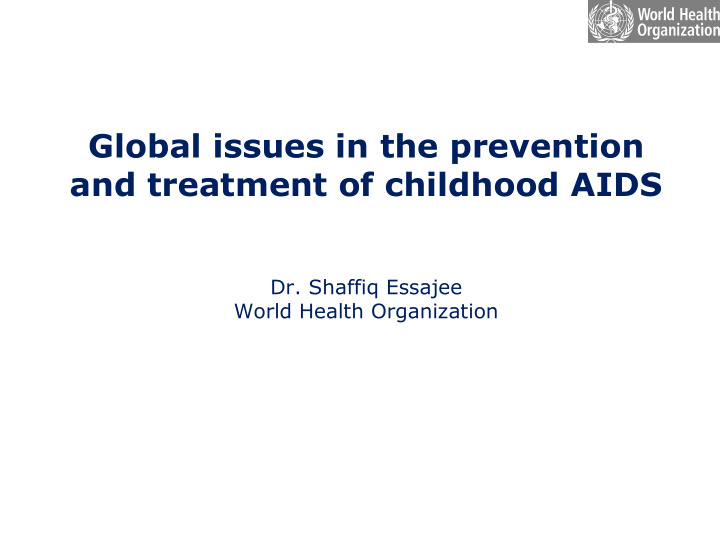



Global issues in the prevention and treatment of childhood AIDS Dr. Shaffiq Essajee World Health Organization
In 2005, global paediatric HIV treatment seemed an impossible dream The past • <30,000 children on treatment worldwide (<5% of children in need of ART) • Very few women were accessing services to prevent vertical transmission • Syrups were the only option for children, the cost was around $500/child/year and dosing was very complex • Infant diagnosis using PCR testing was impossible to access • Very few clinicians had the knowledge and skills to care for children with HIV and paediatric treatment was only available at select tertiary clinics
Five years later, we have made significant progress The past The present • <30,000 children on • >275,000 children on treatment worldwide (<5% of treatment worldwide (40% of children in need of ART) children in need of ART) • Very few women were • Overall about 200,000 accessing services to pediatric infections have prevent vertical transmission been prevented • Syrups were the only option • 5 new paediatric fixed dose for children, the cost was combination tablets are now around $500/child/year and available, cost $60/child/year dosing was very complex with very simple dosing • Infant diagnosis using PCR • Infant diagnosis is more testing was impossible to readily available ~150,000 access tests per year performed • Very few clinicians had the • Thousands of nurses and knowledge and skills to care doctors have been trained, for children with HIV and and paediatric treatment is paediatric treatment was only now available at most ART available at select tertiary centers clinics
Each year, over 100,000 newly diagnosed children start ART Combined paediatric treatment numbers from 20 countries with highest burden of disease Source: UNICEF stocktaking report 2009
But…global progress masks individual country performance: some lag far behind Many countries have achieved >50% of need met. BUT….many are far from there 120,000 100,000 Unmet Need for ART (WHO/UNAIDS) Started on ART in 2009 On ART up to sept 2008 80,000 60,000 40,000 20,000 0 CHAI/UNITAID data Dec 2009 5
And although we start 100,000 children per year on ART, there are 430,000 new infections 250,000 Exposed Infants Untested, 2008 (WHO/UNAIDS) 200,000 PCR Tests, 2009 PCR Tests in 2008 150,000 Pregnant Women Receiving ARVs for PMTCT (WHO/UNAIDS) 100,000 50,000 0 CHAI/UNITAID data Dec 2009 6
As prevention efforts improve, we must look beyond PMTCT to find infected children HIV HIV HIV+ All pregnant pregnant exposed infected women women infants children PMTCT PCR Testing testing Strategies to identify unknown infected children First tier Second tier • Routine offer of testing in • Testing Positive women not tested inpatient wards, TB clinics children in in ANC are not identified and malnutrition units HIV+ social and get no PMTCT services networks and • Proactive testing of children families A n W e g of adult patients enrolled in s t s N N O i l A K E C S S HIV care programs A significant number of infected • Testing infants and children • Door-to-door infants never receive their PCR of unknown status at testing results and are lost to follow-up vaccine or U5 clinics focused on H e h g p v children r i A C S E S W N U O N N K Source: Kellerman & Essajee, PLOS, 2010
“Need” is relative. In reality almost all children would benefit from ART 2006 WHO guidelines: 2010 WHO guidelines: 2010 US guidelines: “Treat the sickest” “Treatment saves lives” “Treat almost all”
And today, Universal Access faces the most serious global economic crisis since 1930's… Resource needs 30 USD billion 20 $13.8 Available resources $11.3 10 $8.8 $7.9 $6.1 $5.0 $3.2 $1.6 $1.4 0 2000 2001 2002 2003 2004 2005 2006 2007 2008 2009 2010 Resources Available for HIV services Resource needs for country defined UA
So what can we do together, as advocates, policy makers and clinicians to turn the wheel WHO National Must develop the Programs and policy guidance to partners encourage suppliers to make cheaper Must adopt testing child friendly & treatment products as a policies set ambitious targets priority and encourage USE of priority products Clinicians Must document experience and engage in operational research to drive policy based on best practice
Recommend
More recommend